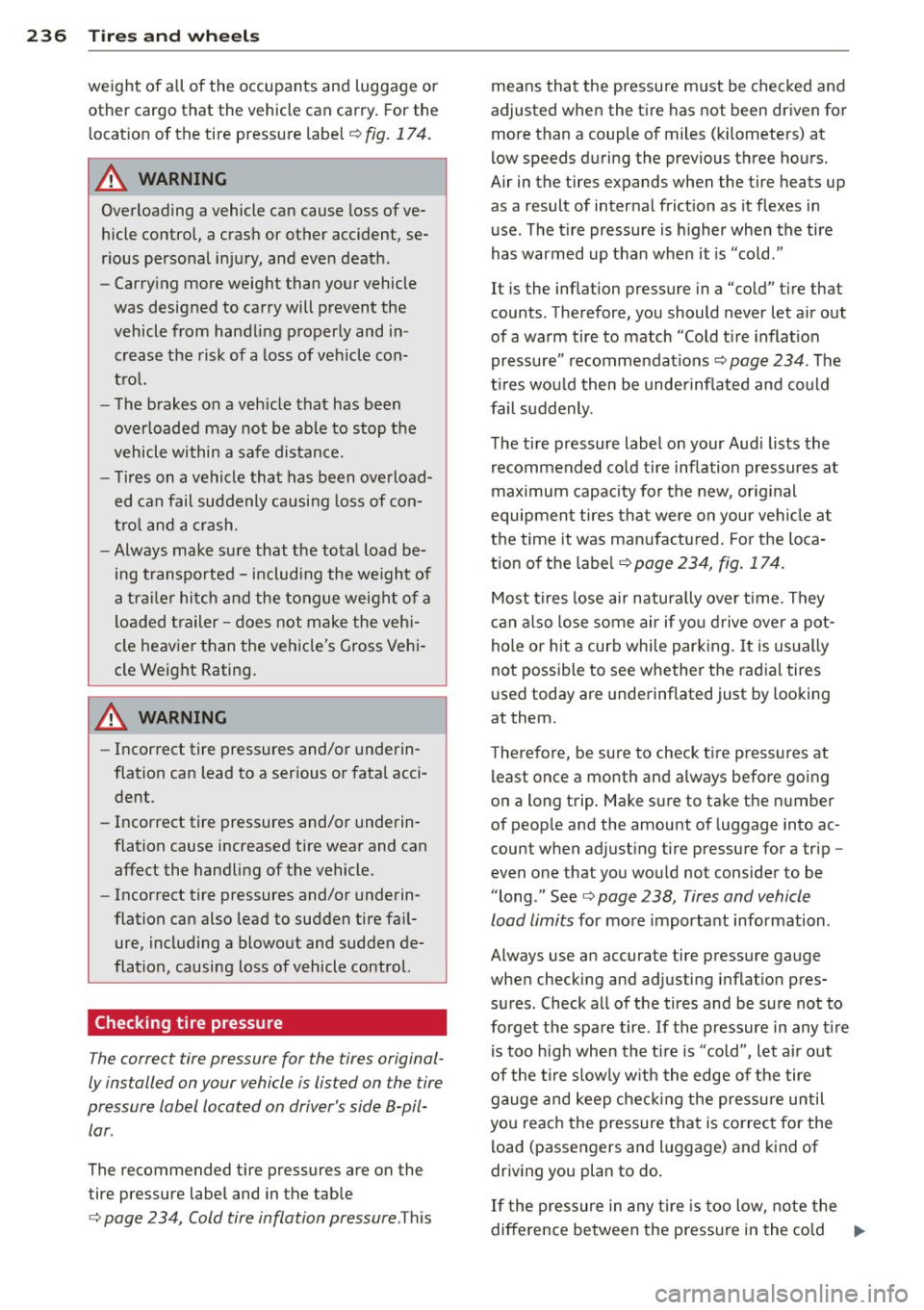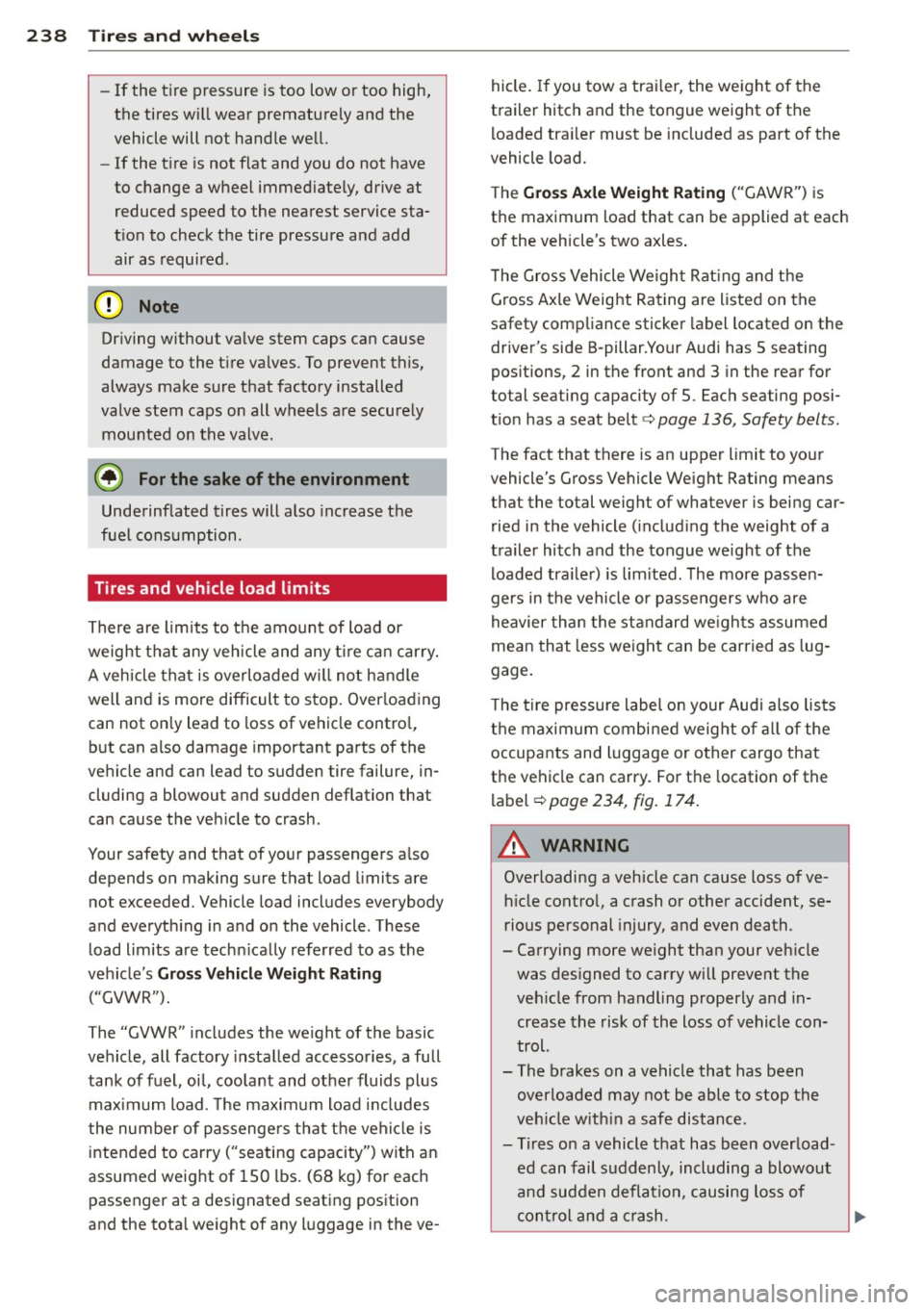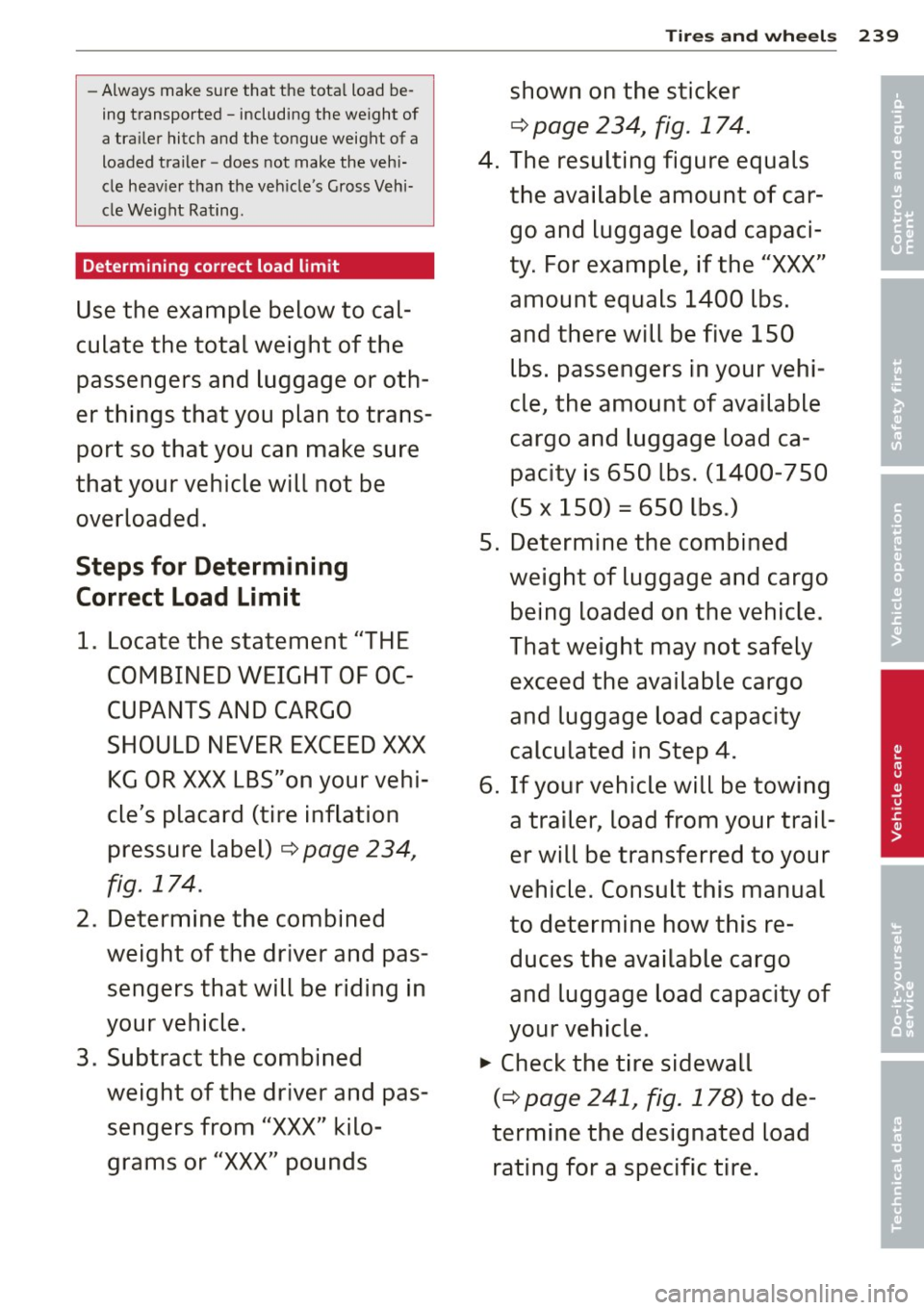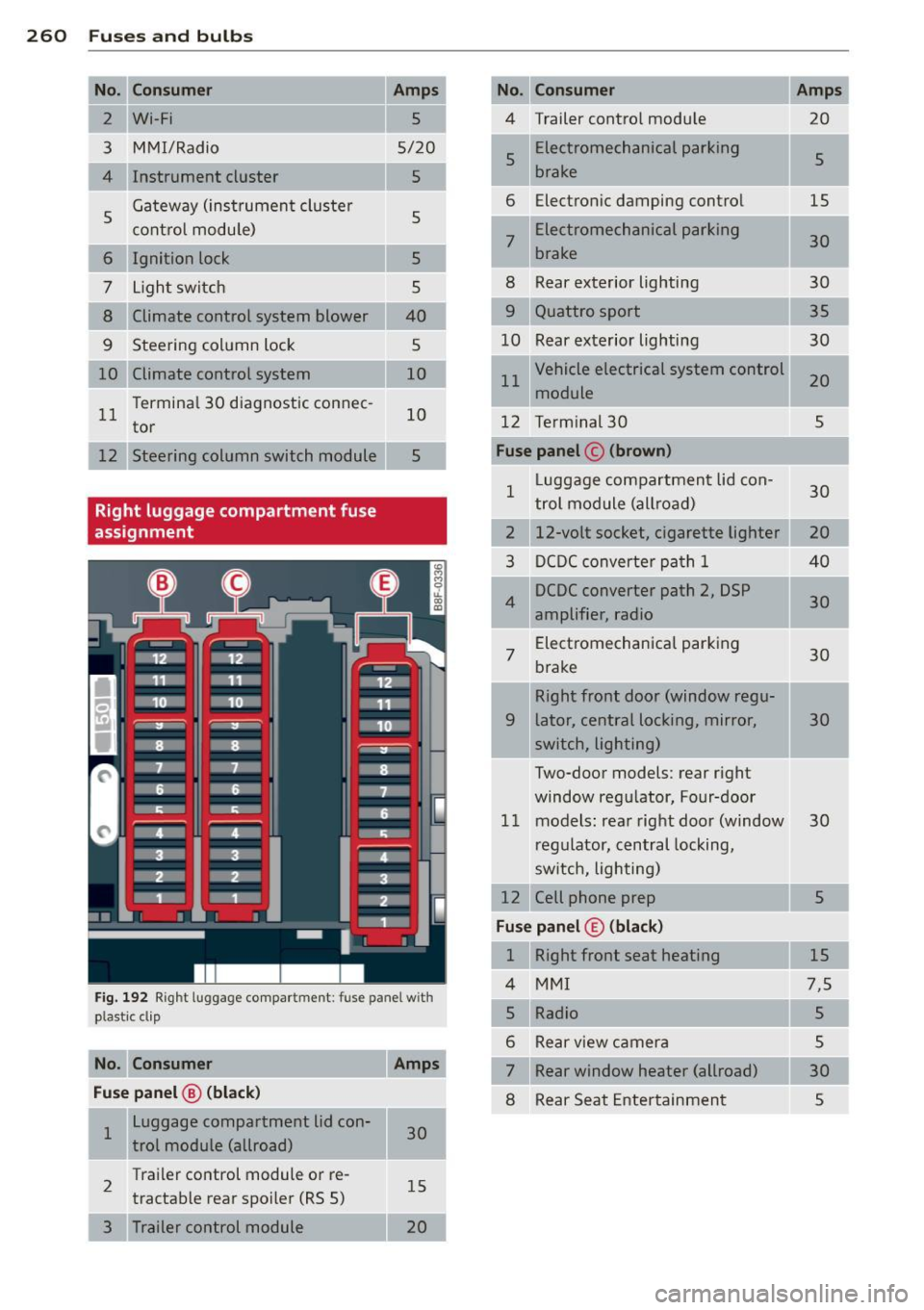2013 AUDI A4 SEDAN trailer
[x] Cancel search: trailerPage 238 of 294

236 Tires and wheels
weight of all of the occupants and luggage or
other cargo that the vehicle can carry. For the
location of the tire pressure label¢
fig. 174.
_& WARNING
Overloading a vehicle can cause loss of ve
hicle control, a crash or other accident, se
rious personal injury, and even death .
- Carrying more weight than your vehicle
was designed to carry will prevent the
vehicle from handling properly and in
crease the risk of a loss of vehicle con
tro l.
- The brakes on a veh icle that has been
overloaded may not be able to stop the
vehicle within a safe distance.
- Tires on a vehicle that has been overload
ed can fail suddenly causi ng loss of con
tro l and a crash.
- Always make sure that the total load be
ing transported -including the we ight of
a trailer hitch and the tongue weight of a
loaded trailer -does not make the vehi
cle heavier than the vehicle's Gross Vehi
cle Weight Rating.
A WARNING
-Incorrect tire pressures and/or underin
flation can lead to a serious or fatal acci dent.
- Incorrect tire pressures and/or underin
flation cause increased tire wear and can
affect the handling of the vehicle.
- Incorrect tire pressures and/or underin
flation can also lead to sudden tire fa il
ure, including a blowout and sudden de
flation, causing loss of vehicle control.
Checking tire pressure
-
The correct tire pressure for the tires original
ly installed on your vehicle is listed on the tire
pressure label located on driver's side 8-pil
lar .
The recommended tire pressures are on the
tire pressure label and in the table
¢ page 234, Cold tire inflation pressure .This
means that the pressure m ust be checked and
adjusted when the tire has not been driven for
more than a couple of miles (kilometers) at
low speeds during the previous three hours.
Air in the tires expands when the tire heats up
as a result of internal frict ion as it flexes in
use. The tire pressure is higher when the tire
has warmed up than when it is "co ld ."
It is the inflation pressure in a "cold" tire that
counts. Therefore, you should never let a ir out
of a warm tire to match "Cold t ire inflat ion
pressure" recommendations ¢
page 234. The
tires would then be underinflated and could
fail suddenly .
The tire pressure label on your Audi lists the
recommended cold tire inflation pressures at
maximum capacity for the new, original
equipmen t tires that were on your vehicle at
the time it was manufactured. For the loca
tion of the labe l
¢page 234, fig. 174.
Most tires lose air naturally over t ime. They
can also lose some air if yo u drive over a pot
hole or hit a curb while parking. It is usually
not possible to see whether the radial tires
used today are underinflated just by looking
at them.
T here fore, be sure to check ti re pressures at
least once a month and a lways before going
on a long trip . Make sur e to take the number
of peop le and the amount of luggage into ac
count when adjust ing tire pressure for a trip -
even one that you would not consider to be
"long ." See ¢
page 238, Tires and vehicle
load limits
for more important information .
Always use an accurate tire pressure gauge
when checking and adjusting inflat ion pres
sures. Check all of the tires and be sure not to
forget the spare tire.
If the pressure in any tire
i s too h igh when the tire is "cold", let air out
of the tire slowly with the edge of the tire
gauge and keep check ing the pressure until
you reach the pressure that is correct for the
load (passengers and luggage) and kind of
driving you plan to do.
If the pressure in any tire is too low, note the
difference between the pressure in the cold .,..
Page 240 of 294

238 Tires and wheels
-If the tire pressure is too low or too high,
the tires will wear prematurely and the
vehicle will not handle well.
- If the tire is not flat and you do not have
to change a wheel immediately, drive at
reduced speed to the nearest service sta
t ion to check the tire pressure and add
air as required.
(D Note
Driving without valve stem caps can cause
damage to the tire va lves. To prevent this,
always make sure that facto ry installed
valve stem caps on all wheels are securely mounted on the valve.
@ For the sake of the environment
Underinflated tires will also increase the
fuel consumption .
Tires and vehicle load limits
There are limits to the amount of load or
weight that any vehicle and any tire can carry.
A vehicle that is overloaded w ill not handle
well and is more difficult to stop. Overloading
can not only lead to loss of vehicle control,
but can a lso damage important parts of the
vehicle and can lead to sudden tire failure, in
cluding a blowout and sudden deflation that
can cause the vehicle to crash .
Your safety and that of your passengers a lso
depends on making sure that load limits are
not exceeded. Vehicle load includes everybody
and everything in and on the vehicle . These
load limits are techn ically referred to as the
vehicle's
Gross Vehicle Weight Rating
("GVWR").
The "GVWR" includes the weight of the basic
vehicle, all factory installed accessories , a full
tank of fuel , oi l, coolant and other fluids plus
maximum load. The maximum load includes
the number of passengers that the vehicle is
intended to carry ("seating capacity") with an
assumed weight of 150 lbs . (68 kg) for each
passenger at a designated seating position
and the tota l weight of any luggage in the ve- hide.
If you tow a trai ler, the weight of the
trailer hitch and the tongue weight of the loaded trailer must be included as part of the
vehicle load.
T he
Gross Axle Weight Rating ("GAWR") is
the maximum load that can be applied at each
of the vehicle's two axles .
T he Gross Vehicle Weight Rating and the
Gross Axle Weight Rating are listed on the
safety compliance sticker label located on the
driver's side B-pillar.Your Audi has 5 seating
positions, 2 in the front and 3 in the rear for
total seating capacity of 5. Each seating posi
tion has a seat belt <=>
page 136, Safety belts .
The fact that there is an upper limit to yo ur
vehicle's Gross Vehicle Weight Rating means
that the to tal weight of wha tever is being car
ried in the vehicle ( including the weight of a
tra iler hitch and the tongue weight of the
loaded trailer) is lim ited. The more passen
gers in the vehicle or passengers who are
heavier than the standard we ights assumed
mean that less we ight can be carried as lug
gage.
T he tire pressure label on your Audi also lists
the maximum combined weight of all of the
occupants and luggage or other cargo that
the vehicle can carry. For the location of the
label <=>page234 , fig.174.
A WARNING
-Overloading a vehicle can cause loss of ve-
hicle control, a crash or other accident, se
rious personal injury, and even death.
- Carrying more we ight than your vehicle
was des igned to carry will prevent the
veh icle from handling properly and in
crease the risk of the loss of vehicle con
trol.
- The brakes on a vehicle that has been
overloaded may not be able to stop the
veh icle with in a safe distance .
- Tires on a vehicle that has been overload
ed can fail suddenly, incl uding a blowout
and sudden deflation, causing loss of
con trol and a crash .
Page 241 of 294

-Always make sure that the total load be
ing transported - including the weight of
a trailer hitch and the tongue weight of a
loaded trailer -does not make the vehi
cle heav ier than the vehicle's Gross Vehi
cle Weight Rating.
Determining correct load limit
Use the example below to cal
culate the total weight of the
passengers and luggage or oth
er things that you plan to trans
port so that you can make sure
that your vehicle will not be
overloaded.
Steps for Determining Correct Load Limit
1. Locate the statement "THE
COMBINED WEIGHT OF OC
CUPANTS AND CARGO
SHOULD NEVER EXCEED XXX KG OR XXX LBS"on your vehi
cle's placard (tire inflation pressure label)
¢ page 234,
fig. 174.
2. Determine the combined
weight of the driver and pas sengers that will be riding in
your vehicle.
3. Subtract the combined
weight of the driver and pas sengers from
"XXX" kilo
grams or
"XXX" pounds
Tires and wheels 239
shown on the sticker
¢ page 234, fig. 174.
4. The resulting figure equals
the available amount of car
go and luggage load capaci
ty. For example, if the
"XXX"
amount equals 1400 lbs.
and there will be five
150
lbs. passengers in your vehi
cle, the amount of available
cargo and luggage load ca
pacity is
650 lbs. (1400-7 50
(5
X 150) = 650 lbs.)
5. Determine the combined
weight of luggage and cargo being loaded on the vehicle.
That weight may not safely
exceed the available cargo
and luggage load capacity
calculated in Step
4.
6. If your vehicle will be towing
a trailer, load from your trail
er will be transferred to your
vehicle. Consult this manual
to determine how this re duces the available cargo
and luggage load capacity of
your vehicle.
.,. Check the tire sidewall
(¢ page 241, fig. 178) to de
termine the designated load rating for a specific tire.
•
•
'
Page 261 of 294

Fuses and bulbs 259
-No. No. Consumer Amps
5 Sound
actuato r/exhaust sound
5/15
tuning 6
Windshield washer system,
35
headlight washer system
.
6 Headlight range control sys-
5/7,5
tern/cornering light 7 Vehicle electrical system control
20
module 1
7 Headlight (cornering light) 7,5
Control modules (electrome-
8
Vehicle electrical system control
30
module 1
'
8
chanical parking brake, shock
5
absorber, quattro sport, trailer
hitch), DCDC converter 9 Sunroof 20
10 Vehicle electrical system control
30
module
1
9 Adaptive cruise control 5
11 Sun shade motor 20
10 Shift gate
5
11 Side assist 5 12 Anti-theft alarm
warning sys-
5
tern
I 12 Headlight range control, park-
5
ing system
Right cockpit fuse assignment
13 Airbag 5
14 Rear wiper (allroad) 15
15 Auxiliary fuse (instrument pan-
10
el)
I 16 Auxiliary fuse terminal 15 (en-
40
gine area)
Fuse panel @ (brown)
2 Brake light sensor 5
3 Fuel pump
25
4
5 Left seat
heating with/without
15/30
seat ventilation
6
7 Horn Front left door (window regula-
8 tor, central locking, mirror, 30
switch, lighting)
Fig. 191 Right cockpit : fuse panel with plastic cl ip
9 Wiper motor 30
10 ESC 25
No. Consumer Amps
Two-door models: rear left win-Fuse panel @ (black)
dow regulator, Four-door mod- 5 Steering column switch module 5
11
els:
rear left door (window regu-
30
lator, central locking, switch, 7 Terminal 15 diagnostic connec-
5
tor
lighting)
12 Rain and light sensor 5
8
Gateway (Databus diagnostic
5
interface)
-..
Fuse panel © (red) 9 supplementary heater 5
3
Fuse panel @ (brown)
4 Dynamic steering
1 CD/DVD player 5
Page 262 of 294

260 Fuses a nd bulb s
I
-No. Consumer
2 Wi-Fi
3 MMI/Radio
4 Instrument cluster
5 Ga
teway (instrument cluster
control module)
6 Ignition lock
7 L igh t switch
8 Climate control system blower
9 Steer ing column lock
10 Climate control system
11 Termina
l 30 diagnostic connec-
tor
12 Steering column switch module
Right luggage compartment fuse
assignment
Amps
5
5/20
5
5 5
5
40 5
10
10
5
Fig. 192 R ig ht l uggag e compar tmen t: fu se pan el w ith
plas tic cl ip
No. Con sumer Amps
Fu se pan el
@ (bl ack )
1 Luggage compartment lid con-
30
trol module (allroad)
2 Trail
er control module or re-
15
tractable rear spoiler (RS 5)
3 Trailer control module
20
No . Consumer
4 Trailer contro l modu le
5 Electromechanical parking
5
brake
6 Elec tronic damping control
15
--
7 Electromechanical parking
30
brake
8 Rear exterior lighting 30
9 Quattro sport
10 Rear exterior lighting
11 Vehicle electrical system control
20
module
12 Te rminal 30 5
Fuse panel© (brown )
1 L
uggage compartment lid con-
30
trol module (all road)
2 12-volt socket, cigarette lighter
20
3 DCDC converter pa th 1 40
4 DCDC converter path 2, DSP
30
amplifier , radio
7 Electromechanical parking
30
b rake
Right front door (window regu-
9 lator, central locking, mirror, 30
switch, lighting)
Two-door models : rear righ t
window regu lator, Four-door
11 models : rear right door (window
30
regulator, central locking,
switch, lighting)
Cell phone prep 5
Fuse panel © (blac k)
1 Right front seat heating
15
4 MMI 7,5
5 Radio 5
6 Rear view camera 5
7 Rear window heater (allroad)
30
8 Rear Seat Entertainment 5
Page 274 of 294

272 Consumer Information
Consumer Information
Warranty coverages
You r Audi is covered by the following war
ranties:
- New Vehicle Limited Warranty
- Limited Warranty Against Corrosion Perfo-
ration
- Emissions Control System Warranty
- Emissions Performance Warranty
- California Emissions Control Warranty (USA
vehicles only)
- California Emissions Performance Warranty
(USA vehicles only)
Detailed information regarding your warran
ties can be found in your
Warranty & Mainte
nance booklet .
Operating your vehicle
outside the U.S.A. or
Canada
Government regu lations in the United States
and Canada require that automobiles meet
specific emission regulations and safety
standards. Therefore, veh icles built for the
U.S.A . and Canada differ from vehicles sold in
other countries .
If you p lan to take your vehicle outside the
continental limits of the United States or Can
ada, there is the possibility that:
- unleaded fuels for vehicles with cata lytic
converter may not be available;
- fuel may have a considerably lowe r octane
rating. Improper fuel may cause engine
damage ;
- service may be inadequate due to lack of
proper service facilities, tools or testing
equipment ;
- replacement pa rts may not be readily availa
ble.
- Navigation systems for vehicles built for the
U.S.A. and Canada will not necessar ily work
in Europe, and may not work in other coun
tries outside of North America.
(D Note
Audi cannot be responsible for mechanical
damage that could result from inadequate
fuel, service or parts availability.
Audi Service Repair Manuals and Literature
Audi Official Factory Service Manuals and Lit
erature are published as soon as possible after
model introduction. Service manuals and lit
erature are available to order from the Audi
T echnical Literature Ordering Center at:
www.audi.techliterature.com
Maintenance
General
Your vehicle has been designed to help keep
maintenance requirements to a minimum.
However, a certain amount of regular mainte
nance is still necessary to assure your vehicle's
s afety, economy and rel iability. For detailed
vehicle maintenance consult your Warranty &
Maintenance booklet.
Under difficult operating conditions, for ex
ample at extremely low outside temperatures,
i n very dusty regions , when towing a trailer
very frequently, etc., some service work
should be performed between the intervals
specified. This applies particularly to:
- oil changes, and
- cleaning or replacing the air filter .
(® For the sake of the environment
By regularly maintaining your vehicle, you
help make sure that emission standards
are maintained, thus minimizing adverse
effects on the environment.
Important considerations for you and
your vehicle
The increasing use of electronics, sophisticat
ed fuel injection and emission contro l sys-
tems, and the genera lly increasing technical
liJJ,
Page 290 of 294

288 Index
Tires and wheels
Checking tire pressure .............. 236
Cold t ire inflation pressure ... .. .... . 234
Dimensions .............. .. .. .... . 241
General notes . ............. .. .... . 230
Glossary of tire and loading terminolo -
gy .. .. .. .. ... .... ...... .. .. .. .. . 231
New tires and wheels .......... .. .. . 241
Replacing . . . . . . . . . . . . . . . . . . . . . . . . 242
Snow chains .. ........... .. .. .... . 246
Tires and vehicle load limits . ... .. .. . 238
Wheel bolts .............. ... .... . 247
Winter tires .............. ... .... . 245
Tire service life . ........... .... .... . 240
Tool kit . .. ................. .. .... . 251
Torn or frayed safety belts ............ 139
Touch-up paint . .. ...... .... ... .. .. . 202
Towing Front eyelet ............. .. .. ..... 265
Rear eyelet ... ........... .... .... . 265
Tow truck procedures .......... .. ... 264
TPM5 Tire pressure monitoring system .. ... 249
Trailer towing ... .......... .. .. .. .. . 196
Operating instructions ......... .. .. . 196
Technical requirements . . . . . . . . 196, 197
Tips ..... .. ................ ..... . 198
Transmission ............ .. .. .. .. .. .. 83
6-speed manual transmission . . . . . . . . . 83
multitronic . . . . . . . . . . . . . . . . . . . . . . . . 83
S tronic .... ................ ..... .. 89
tiptronic . . . . . . . . . . . . . . . . . . . . . . . . . . 83
Transmission malfunction (ind icator lamp) 95
Transmission malfunction (indicator light) 88
Transport Canada ................... 134
Travel mode ... .. ...... .... ... .. .. .. 46
Tread Wear Indicator (TWI) ... ... .. .. . 240
Trip computer
Fu el consumption . . . . . . . . . . . . . . . . . . 25
Mileage .................... ..... .. 25
Sing le-trip memory ........ ..... .. .. 25
Total-trip memory . . . . . . . . . . . . . . . . . . 25
Trip odometer ............. .... .... .. 12
Trunk
refer to Luggage compartment . . . 64, 132
Trunk escape handle ................ .. 40 Trunk
lid
refer to Rear lid . ................. .. 39
Turn signals . .... .. ............. ..... 45
Warning/indicator lights .......... .. . 23
u
Undercoating ..... ................ . 204
Unfastening safety belts ......... .. ..
141
Unidirectional tires .............. .... 230
Uniform tire quality grading .......... 244
Unlocking Rear lid ... .... .. ................. . 39
Unlocking/locking at the lock cylinder . . . . . . . . . . . . . . . . . . 3 7
by remote control ................ .. 35
with the centra l locking switch ..... .. . 36
with the convenience key ...... .. .. .. . 36
Use of jumper cables ............ .... 263
V
Valet parking ...... ................ .. 43
Vanity mirrors ..... ............. ..... 49
Vehicle-care products . . . . . . . . . . . . . . . . 199
Vehicle electrical system . . . . . . . . . . . . . . 17
Vehicle Identification Number (VIN) .. .. 268
Vehicle jack . .. .. .. ... .......... .... 255
Vehicle key . . . . . . . . . . . . . . . . . . . . . . . . . 33
Vehicle literature .. ............. ...... 5
Vehicle tool kit . ... ....... ...... .. .. 251
Ventilation . .. .. .. ............. .. .. . 68
w
Warning/indicator lights . . . . . . . . . . 10 , 13
Airbag system ... ................ .. 20
Anti-lock braking system (ABS) . .. .. .. . 19
Brake system .. .. ... .......... .. .. . 15
Electromechanical parking brake . .. .. . 16
Electronic power control . . . . . . . . . . . . . 20
Electronic Stabilization Control (ESC) .. . 19
Generator . . . . . . . . . . . . . . . . . . . . . . . . . 17
Malfunction Ind icator Lamp (MIL) .... . 20
Safety belt . . . . . . . . . . . . . . . . . . . . . . . . 17
Safety systems . . . . . . . . . . . . . . . . . . . . . 20
Turn signals ..... ................ .. 23
Warranty coverages ................. 272